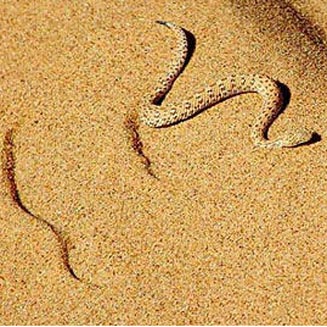|
Bitis peringueyi (Peringuey's desert or side-winding adder,
Namib dwarf sand-adder)
Peringuey se adder, Namibduinadder [Afrikaans]
Life >
Eukaryotes
>
Opisthokonta >
Metazoa
(animals) > Bilateria > Deuterostomia >
Chordata >
Craniata > Vertebrata (vertebrates) > Gnathostomata (jawed vertebrates) >
Teleostomi (teleost fish) > Osteichthyes (bony fish) > Class:
Sarcopterygii (lobe-finned fish) > Stegocephalia (terrestrial vertebrates) >
Tetrapoda
(four-legged vertebrates) > Reptiliomorpha > Amniota >
Reptilia (reptiles) >
Romeriida > Diapsida > Lepidosauromorpha > Lepidosauria >
Squamata > Serpentes
(snakes) > Family: Viperidae > Genus:
Bitis
 Bitis peringueyi (Peringuey's desert or side-winding adder,
Namib dwarf sand-adder), Namibia [W. Botha ©
from
SARCA Virtual Museum] |

Bitis peringueyi (Peringuey's desert or side-winding adder,
Namib dwarf sand-adder), Namibia [W. Botha ©
from
SARCA Virtual Museum |
Identification
Can be identified by its orange brown or greyish yellow
colouration, three rows of pale spots along its body, its often black tipped tail and
its eyes which are on top of its head (this is because the snake often conceals
itself in loose sand with its eyes peeping out). It has an average length of 25 cm but may reach 33 cm in
length.
Distribution and habitat
Restricted to the Namibian West
Coast. Its favoured habitat is coastal sand dunes (it is in this environment that
it is most often seen side winding).
Food
Feeds on lizards (particularly Sand lizards) and geckos
(particularly the Barking gecko).
Predators, parasites and disease
Threatened by habitat destruction and illegal collecting.
Reproduction
Viviparous (gives birth to live young); three to 10 young
are born in late summer.
Longevity
Has an average lifespan of 10 years.
Medical importance
Has a weak cytotoxic venom which causes
pain and swelling. Antivenom is not necessary.
Links
References
-
Broadley, D.G. 1983. FitzSimons' Snakes of Southern
Africa. Delta Books, Johannesburg.
-
Marais, J. 2004. A Complete Guide to Snakes of Southern Africa.
Struik Publishing, Cape Town.
|
